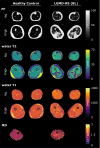Multi-parametric quantitative MRI of the lower limb muscles in a longitudinal study of limb-girdle muscular dystrophy R9
- PMID: 40293996
- PMCID: PMC12036925
- DOI: 10.1371/journal.pone.0321463
Multi-parametric quantitative MRI of the lower limb muscles in a longitudinal study of limb-girdle muscular dystrophy R9
Abstract
Background and objectives: Limb-girdle muscular dystrophy R9 (LGMD-R9) is a rare neuromuscular disease with no curative treatment. Sensitive non-invasive biomarkers are necessary to monitor disease progression and evaluate the efficacy of novel therapies. Here, we investigated several quantitative MRI parameters as suitable biomarkers for evaluating disease progression in LGMD-R9.
Methods: Bilateral quantitative MRI of the lower limbs was performed in individuals with LGMD-R9 and healthy controls. Quantitative thigh and leg muscle MRI, functional tests (including time-up-and-go (TUG) and time-to-climb-4-stairs (4S climb)), and muscle strength tests were performed in individuals with LGMD-R9 at baseline, 1-year, and 2-years. qMRI included assessment of muscle fat fraction (FF), water T2, water T1, intramuscular pH from 1H MR spectroscopy, and diffusion tensor imaging (DTI) parameters. Differences between LGMD-R9 and controls, over time, and the relationship between baseline water T1 and water T2 parameters and disease progression (FF, functional and strength parameters) were assessed by linear mixed models and correlation analyses.
Results: 18 individuals with LGMD-R9 and 13 controls were enrolled. At baseline, elevated FF, water T2, water T1, and pH were observed in LGMD-R9 (p < 0.05). No differences between controls and LGMD-R9 were found in the DTI parameters. An overall tendency to an increase in FF and a decrease in functional measures were observed over 2 years. However, the changes did not reach significance (p = 0.057-0.752). Baseline water T1 and baseline water T2 correlated with the increase in FF (ΔFF) and change in TUG (ΔTUG) and 4S climb (Δ4S climb) over 2 years (correlation coefficient ≥ 0.6, p < 0.05). No correlation with the strength measures was found.
Conclusion: Our findings suggest that FF, water T2, water T1, and pH are effective biomarkers for LGMD-R9. The correlation of water T2 and water T1 with ΔFF, ΔTUG, and Δ4S climb suggests their potential in predicting disease progression.
Copyright: © 2025 Rauh et al. This is an open access article distributed under the terms of the Creative Commons Attribution License, which permits unrestricted use, distribution, and reproduction in any medium, provided the original author and source are credited.
Conflict of interest statement
S. Olivier is a full-time employee of Atamyo Therapeutics. R. Zanfongnon is a full-time employee of Généthon. The Institute of Myology received payments from Généthon for the work as a central reader in the overall GNT-015-FKRP natural history study. Généthon provided support in the form of salaries for authors regarding the central reading of the data. Généthon and Atamyo Therapeutics did not have any additional role in the study design, data collection and analysis, decision to publish, or preparation of the manuscript. The specific roles of these authors are articulated in the “author contributions” section.
Figures






References
MeSH terms
LinkOut - more resources
Full Text Sources
Medical

